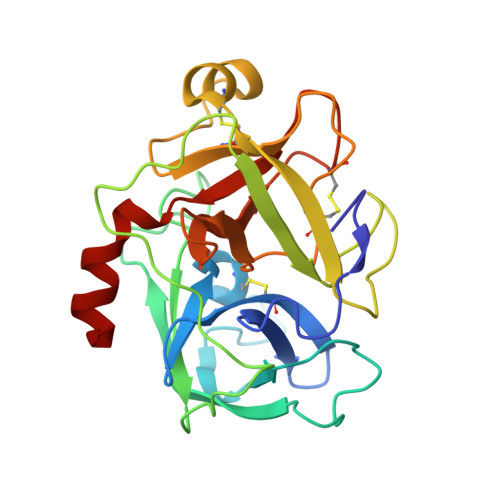Secondary Amides of Sulfonylated 3-Amidinophenylalanine. New Potent and Selective Inhibitors of Matriptase.
Steinmetzer, T., Schweinitz, A., Sturzebecher, A., Donnecke, D., Uhland, K., Schuster, O., Steinmetzer, P., Muller, F., Friedrich, R., Than, M.E., Bode, W., Sturzebecher, J.(2006) J Med Chem 49: 4116-4126
- PubMed: 16821772
- DOI: https://doi.org/10.1021/jm051272l
- Primary Citation of Related Structures:
2GV6, 2GV7 - PubMed Abstract:
Matriptase is an epithelium-derived type II transmembrane serine protease and has been implicated in the activation of substrates such as pro-HGF/SF and pro-uPA, which are likely involved in tumor progression and metastasis. Through screening, we have identified bis-basic secondary amides of sulfonylated 3-amidinophenylalanine as matriptase inhibitors. X-ray analyses of analogues 8 and 31 in complex with matriptase revealed that these inhibitors occupy, in addition to part of the previously described S4-binding site, the cleft formed by the molecular surface and the unique 60 loop of matriptase. Therefore, optimization of the inhibitors included the incorporation of appropriate sulfonyl substituents that could improve binding of these inhibitors into both characteristic matriptase subsites. The most potent derivatives inhibit matriptase highly selective with K(i) values below 5 nM. Molecular modeling revealed that their improved affinity results from interaction with the S4 site of matriptase. Analogues 8 and 59 were studied in an orthotopic xenograft mouse model of prostate cancer. Compared to control, both inhibitors reduced tumor growth, as well as tumor dissemination.
Organizational Affiliation:
Curacyte Chemistry GmbH, Winzerlaer Strasse 2, D-07745 Jena, Germany. torsten.steinmetzer@curacyte.com















